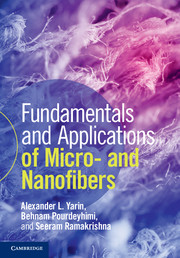Book contents
- Frontmatter
- Contents
- Preface
- 1 Introduction
- 2 Polymer physics and rheology
- 3 General quasi-one-dimensional equations of dynamics of free liquid jets, capillary and bending instability
- 4 Melt- and solution blowing
- 5 Electrospinning of micro- and nanofibers
- 6 Additional methods and materials used to form micro- and nanofibers
- 7 Tensile properties of micro- and nanofibers
- 8 Post-processing
- 9 Applications of micro- and nanofibers
- 10 Military applications of micro- and nanofibers
- 11 Applications of micro- and nanofibers, and micro- and nanoparticles: healthcare, nutrition, drug delivery and personal care
- Subject Index
- References
11 - Applications of micro- and nanofibers, and micro- and nanoparticles: healthcare, nutrition, drug delivery and personal care
Published online by Cambridge University Press: 05 June 2014
- Frontmatter
- Contents
- Preface
- 1 Introduction
- 2 Polymer physics and rheology
- 3 General quasi-one-dimensional equations of dynamics of free liquid jets, capillary and bending instability
- 4 Melt- and solution blowing
- 5 Electrospinning of micro- and nanofibers
- 6 Additional methods and materials used to form micro- and nanofibers
- 7 Tensile properties of micro- and nanofibers
- 8 Post-processing
- 9 Applications of micro- and nanofibers
- 10 Military applications of micro- and nanofibers
- 11 Applications of micro- and nanofibers, and micro- and nanoparticles: healthcare, nutrition, drug delivery and personal care
- Subject Index
- References
Summary
Nanotechnology has profound applications in healthcare and has improved healthcare research to a large extent. The therapeutic benefits of nanotechnology in the field of medicine have resulted in new areas, such as nanomedicine, nanobiotechnology, etc. Researchers in the field are attempting to find an effective nanoformulation to deliver growth factors, supplements or drugs safely and in a sustained manner at the required site. Their task is to attempt a different drug nanoformulation of existing blockbuster drugs that brings improved efficacy and a therapeutic breakthrough. Thus the ultimate objective of these nanotechnological drug-delivery systems is to fine tune the normal profile of potent drug molecules in the body following their administration to significantly improve their efficacy and also minimize potential intrinsic severe adverse effects. For treatment of breast cancer and non-small-cell lung cancer, Abraxane® (paclitaxel) is employed as a nanoparticular formulation, which increases drug delivery up to 70% in comparison with solvent-based paclitaxel delivery. In this novel nanoformulation, Abraxis Bio Sciences have used Bristol-Meyers Squibb’s blockbuster drug paclitaxel (Taxol) and a very common globular protein bovine serum albumin (BSA). There are numerous nanotechnology-based drug-delivery systems such as nanocrystals, nanoemulsions, lipid or polymeric nanoparticles, liposomes and nanofibers. While nanoemulsions and liposomal formulations did not make significant advances, despite huge research spending, the polymeric nanoparticulate systems show more promise. Nanoparticles of a polymeric nature find application as drug-delivery systems and are advantageous due to their scalability, cost, controlled and targeted delivery, compatibility, degradability, etc. Natural biopolymers are even better than the synthetic polymers in terms of biocompatibility and biodegradability. Nanoparticulate drug formulations alter the pharmokinetic profile of the therapeutic entity and program the release of the drug in sustained or controlled manner. Thus, nanoparticle or nanoformulated drugs outperform conventional systemic delivery in terms of delivery of an encapsulated drug and its sustained release. Slowly and surely nanoformulated drugs are coming onto the market, surpassing systemic delivery, which is believed to be the only mode of administration for a wide range of active pharmaceutical ingredients. Nanofibrous drug-delivery systems are being developed as potential scaffolds in tissue regeneration, wound healing and cancer drug-delivery applications. In this chapter we are going to discuss two promising nanotechnology-based drug-delivery tools, namely electrospun micro- and nanofibers and electrosprayed micro- and nanoparticles, which have a common synthetic procedure mediated by an electrical potential difference.
- Type
- Chapter
- Information
- Fundamentals and Applications of Micro- and Nanofibers , pp. 380 - 431Publisher: Cambridge University PressPrint publication year: 2014
References
- 1
- Cited by

